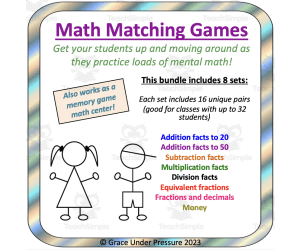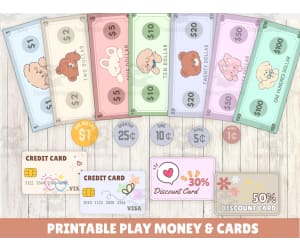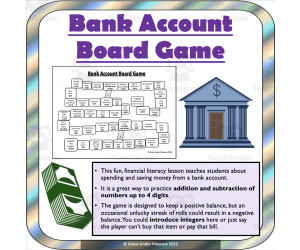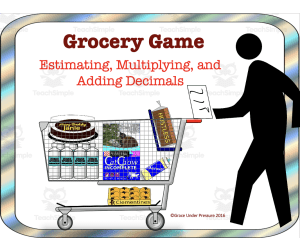2,786 products added recently
Money Games
Introduce financial literacy with money games that make learning about currency enjoyable. This collection includes making change challenges, budgeting simulations, and shopping scenarios. By incorporating these money games into your lessons, you can build practical math skills.
5th grade 6th grade Christmas Math Activity: Digital and Print
Common Core, Math, Addition and Subtraction, Decimals, Fractions, Graphing, Measurements, Money, Multiplication and Division, Grade 5, 6, Word Problems, Worksheets & Printables, Centers, Activities, Escape Room, Games
The time before the holidays can get a little crazy in the classroom. Students are ready for a break and teachers are too! Keep your class engaged with EIGHT Days of math review! The ACTIVITIES are suitable for 5th grade and 6th grade. They are great for easy and fast sub plans. I use them as an 'end of the day carrot' that my students look forward to. They can't leave for the day without getting a step closer to finding Santa so it helps them to stay focused throughout the day so that we have time for the fun activity at the end of the day. One of the best parts: NO PREP required! This is not only great for distance learning but also great if you have run out of copies for the month and need a digital version fast... or if you just forget to make your copies for the week. (It's happened to me! - too. many things to keep track of) The pages do print beautiful in color and black and white if you have the time, but don't fret if you don't. Just assign it on Google Classroom - directions included. If you haven't taught the topic yet, it is a great mini lesson and if you have taught it, it can act as a review. (There are also some fun logic puzzles sprinkled in.) dividing decimals multiplying decimals dividing whole numbers multiplying whole numbers adding decimals subtracting decimals deducing information measurement conversions practicing with money problem solving graphing predicting and having fun! Each task builds off the next. Students will get clues as to where Santa might be hiding AFTER they correctly solve each math task. And don't worry, there is an ANSWER KEY. This resource lends itself to independent work but students can also work in groups of pairs to solve. Don't forget about the other holidays! There is a themed math activity in my store for each of the following: St. Patrick's Day: Find the Leprechaun Easter: Find the Easter Bunny Cinco de Mayo: Find the Piñata
Author Big Apple Teaching
Tags Math Challenge, Find Santa, Decimals, Division, Multiplication, Word Problems, Logic Puzzle, Graphing, Money
Math Matching Games: 8 Sets of Math Fact Cards for Addition, Subtraction, Multiplication, Division, Fractions, Decimals, and Money
Special Resources, Life Skills, Math, Fact Families, Early Math, Addition and Subtraction, Addition, Decimals, Multiplication and Division, Division, Money, Fractions, Multiplication, Grade 2, 3, 4, 5, 6, Activities, Games
Math Matching Games: 8 Sets of Math Fact Cards Here's a great set of math games to add to you curriculum in grades 2-6. There are 8 different sets of cards to practice math skills across several grades. How to Use: I like using these matching games as a warm-up or as a reward at the end of class. Simply shuffle one of the sets and give each student one card. Give the students a moment to determine their card’s value. Then all students stand up and move SILENTLY around the room. ***(I love having this guaranteed moment of quiet)*** Students show their cards to each other and look for their match/card with the same value (ex. 9+9 and 15+3). Matches move to the side of the room until everyone is paired up. Then you can re-deal and play again! Card Sets Included: Each set has 16 pairs- enough for a class with up to 32 students! Addition facts up to twenty Addition facts up to fifty Subtraction facts Multiplication facts Division facts Equivalent fractions Fraction to decimal conversions Money Grades to Use With: These matching sets can work from grade 2 through 6 depending on which sets you use! Addition and subtraction facts are great for grade 2. Multiplication and division facts and money are great for grades 3-4. Equivalent fractions and fraction to decimal conversions are great for grades 5-6. And any sets can be used to review previously learned skills! What's Included: A total of 33 pages in PDF Format: Title Page and 8 sets of cards with 32 cards in each set. If you enjoy this math game , check out others in my store: Exponent Board Game: Fun and Engaging Math Game for 6th Grade Pre-Algebra: Expression Input Output Game Times Table Game: Multiplication Strategies and Commutative Property
Author Grace Under Pressure
Tags Memory Game, Math Game, Math Facts, Fractions, Decimals, Money, Math Center, Times Tables, Addition And Subtraction, Multiplication And Division
Printable pretend money, coins and card
Money, Math, Art, Creative Arts, Finance, Life Studies, Montessori, Elementary, Pre-K, Games, Activities, Crafts
Money, an important yet not many one learn how to manage it. Use this pretend play money to teach kids about money, value, recognising the color, numbers and more. This is an instant digital download is perfect for kids’ when they use it as pretend play, buying and selling activities, and hands-on money learning. An easy-to-make printable set designed for homeschooling, classroom use, math lessons, and creative play. Help your children today to learn more about money in a fun and engaging way. Teach them to save, to spend and to manage. Just simply print, cut, and start playing right away! Prefect for educational activity for homeschooling, classroom teaching, math practice, and imaginative play. You will receive: 2 PDF files (13 pages total) of ready-to-print and cut pretend play money in A4 size and US Letter Includes paper money, coins, a credit card, and a discount card 1 JPEG folder 1 PNG folder 1 SVG folder About this item: Recommended paper weight: 120–140 gsm for best results Estimated creation time: 10–20 minutes Note: You don't need cutting machine and can easily cut it yourself.
Author Jenstrokeandstyle
Rating
Tags Pretend Money, Printable Money, Learn About Money, Fake Money, Pretend Play, Pretend Buy And Sell, Money Lesson, Money, Cash, Printable Cash
Online Lemonade Stand Project
Life Studies, Finance, Home Economics, Business, Math, Money, Grade 5, 6, 7, 8, 9, 10, 11, 12, Activities, Projects, Games
The Online Lemonade Stand Project Whether you're a public school teacher or a homeschooler, the Online Lemonade Stand Project is a resource that brings practical business principles into your classroom. Designed to simulate an engaging and realistic lemonade stand experience, this project provides an innovative educational approach for students from grade 5 up to grade 12. Nurturing Financial Literacy and Entrepreneurship The Online Lemonade Stand Project takes on the challenges of presenting financial literacy and economic insights to students in a way that is both age-appropriate and dynamic. At its core, it's about giving your pupils practical application of entrepreneurship knowledge within the confines of their learning environment; their very own virtual lemonade stand! An Interactive Experience In this interactive activity , students are tasked with managing every aspect of running a profitable lemonade stand online. From calculating production costs to creating effective pricing strategies, they will experience first-hand how supply and demand dynamics can impact business success. Data trackers: Included in the project materials are data trackers specifically designed for student use. Analyzing outcomes: These help learners analyze outcomes from different strategies. Making adjustments: Identifying areas for potential enhancement and making necessary adjustments as if they were running real-life businesses. Curriculum Alignment Aligned with life studies and math curricula including focus areas such as finance, home economics, business and money management; this learning project isn't just about teaching entrepreneurship concepts but also reinforcing math skills in real-world contexts. Greatest Benefit? The great thing about The Online Lemonade Stand Project? It's highly adaptable! Whether used during whole group lessons or small group activities - even as homework assignments - it accommodates diverse educational needs across multiple grade levels. Yet despite its versatility,the unifying goal remains consistent: To equip students with critical thinking skills essential in today's global economy whilst offering them unique opportunities to learn beyond textbooks through active exploration in digital spaces. If you're looking for versatile yet substantive teaching resources that bring education closer to life experiences – consider integrating The Online Lemonade Stand Project into your curriculum!
Author Mister G's Teacher Shop
Tags Interactive Activity, Financial Literacy, Entrepreneurship, Math Skills, Practical Application, Project Lemonade, Online Lemonade Stand, Lemonade Stand Online, Lemonade Stand Lesson Plans, Lemonade Stand Online Games
Coin Bingo
Math, Money, Kindergarten, Preschool, Grade 1, 2, 3, Activities, Games
Coin Bingo - Making Learning Fun And Engaging Coin Bingo is a leading teaching resource designed to meet the needs of educators and homeschoolers working with preschool to grade 3 learners. Its purpose is to assist children in learning about coins, their values and understanding basic facts, while laying the foundation for crucial monetary knowledge. As an interactive game , Coin Bingo not only enriches students' mathematical competencies but also enlivens their learning experience. The game finds its unique advantage by fusing education with entertainment, creating an ideal platform for both whole group sessions and small group activities. What's included? The pack comes with 48 clue cards that cater different levels of challenge. Included are eight distinct versions of the bingo game boards. Perfect for a range of learners needing different levels of coin identification tasks. Bonus feature: An exciting extra within this resource; A special coin-rubbing worksheet that adds even more fun to learning! This means more hands-on interaction which could result in heightened interest and retention on coin properties. To Use: No complex processes needed - simply download as it comes as a ready-to-use PDF file type. Coin Bingo - transforming daunting lessons into enjoyable interactions whilst mastering key skills to handle money related tasks!
Author The Proactive Classroom
Tags Coin Identification, Money Tasks, Math Skills, Interactive Learning, Fun Education
Euro Money Games
Math, Money, Elementary, Homeschool Resources, Centers, Activities, Games
This is a PDF that is 60 pages. It is a packet of five different games that help students practice counting money and getting familiar with Euro currency. Game 1- Trade Up: focus on trading and counting money. Game 2- Money Race to a Euro- players race to make a Euro. Game 3- Memory with Bills and Coins Game 4- Money War - - - - - - - - - - - - - - - - - - - - - - - - - - - - - - - - - - - - - - - - - - - - - - - - - - - - - - - - - - - - - - - - - - - - - - - - - - - - - - - - - - - - - - - - - - - - - - - - - - - - - - - - - - - - - - - - - - - - - - - - - - - - - - - - - - - - - - - - - - - - - - - - - - - - - - - - - - - - - - - - - - - - - - - - - - - - - - - - - - - - - - - - - - - - - - - - - - - - - - - - - - - - - - - - - - - - - - - - - - - - - - - - - - - - - - - - - - - - - - - - - - - - - - - - - - - - - - - - - - - - - - - - - - - - - - - - - - - - - - - - - - - - - - - - - - - - - - - - - - - - - - - - - - - - - - - - - - - - - - - - - - - - - - - - - - - - - - - -
Author CraftEdPrints
Tags Euro, Eurogames, Eurocenters, Money
Bank Account Board Game: A Fun, Financial Literacy Lesson for Addition, Subtraction, or Integer Practice (Grades 3-7)
Special Resources, Life Studies, Special Education Needs (SEN), Life Skills, Math, Addition and Subtraction, Addition, Subtraction, Money, Finance, Home Economics, Grade 3, 4, 5, 6, 7, Activities, Games
Bank Account Board Game: A Fun, Financial Literacy Lesson for Addition, Subtraction, or Integer Practice (Grades 3-7) Do you want to give your students real world math practice for addition and subtraction up to 4 digits? Do you want to show them how the math they learn in the classroom is helpful in everyday life? Do you want to find a way to have them practice loads of math without even noticing? Then this financial literacy board game is perfect for you! How to Use: Print the two page handout double-sided for each student. Go through the bank account vocabulary together as a class. Then give your students time to try to match the vocabulary words to the clues. Next, talk about what actions help your bank balance and what actions hurt it, and try to think of more examples as a class. Now you are ready for the game! Print a game board for each group of 2-4 students, have six-sided dice, and small objects to use as counters. The game’s main objective is to educate students about financial literacy concepts such as spending (withdrawing) and saving (depositing) money within the context of a bank account. Each child takes turns rolling a six-sided die while using counters on the board. Students start with a $300 bank balance, and each turn leads them to a realistic scenario that increases or decreases their balance. I encourage students to use a scrap piece of paper to keep a running tally of their balance throughout the game. Although rare, some sequences of turns can result in negative balances. If this occurs, you can help your students use integers to calculate a negative balance OR create a rule that students can not have a balance below zero, so they can not complete that action and must miss. a turn. Grades to Use With: This game is perfect for students in grades 3-7 who are practicing adding and subtracting with numbers into the thousands. It can be used as a review for this math skill or in conjunction with a financial literacy unit. What's Included: 4 Page PDF: Teacher Instructions 2 Page Lesson/Worksheet 1 Page Game Board
Author Grace Under Pressure
Tags Financial Literacy, Addition And Subtraction, Math Game, Budget, Bank Account, Integers, Real World Math, Board Game, Addition, Subtraction
Grocery Game: Estimating, Adding, and Multiplying Decimals
Life Studies, Math, Addition and Subtraction, Addition, Decimals, Multiplication and Division, Division, Money, Home Economics, Grade 3, 4, 5, 6, Activities, Games
This powerpoint presentation is based on the popular game show "The Price Is Right." It is a fun, whole class activity that you need to be able to project in your classroom on an interactive whiteboard or screen-share for distance learning. As students play along, they practice estimating to stay within a shopping budget. They have to multiply and add with decimal numbers: all helpful realistic applications. My students absolutely love playing this game , and I have included three rounds so you can play more than once! Instructions: 1) Decide on a target range. A higher range will require more challenging multiplication. If the range is tighter, it will be more difficult to win. I usually use a range such as $50-$52. 2) Tell students they must buy at least 4 of the 5 products. Students need to have a piece of paper and a pencil for calculations. 3) Choose a student to pick the first product. She needs to estimate the price for one of them, decide how many she wants to buy, and estimate how much that will cost. “I think the cheese is about $5, I want 3, so that will be around $15.” 4) Then show the price (by moving the red box with your cursor), and all students calculate the cost by hand. For example, 3 x 5.75 = 17.25. This is the start of the running total. 5) Choose another student to buy the second product. Again, have him or her estimate before calculating. Then allow all the students to calculate the cost of the second product. For example 4 x 3.19 = 12.76. 6) Now students have to switch from multiplying to adding decimals. They add the price of the second product to their running total. 17.25 + 12.76 = 30.01 7) Continue with the third, fourth, and fifth (if necessary) product. 8) Students try to spend between $50-52. It’s not always easy! Talk to the class about different strategies such as saving an inexpensive product for the end. If you like this Grocery Game , try another one! Fall Edition Winter Edition
Author Grace Under Pressure
Tags Grocery Game, Estimating, Adding Decimals, Multiplying Decimals, Budget, Price Is Right, Math Game, Estimate, Decimal Operations, Money, Estimation With Decimals, Estimating With Decimals, Estimation Of Decimals, How Do You Estimate Decimals
Dollars and Cents Card Game
Math, Money, Grade 3, 4, Activities, Games
The Dollars and Cents Card Game An engaging, skill-building resource for educators looking to incorporate an interactive element into their math curriculum . Focused on students in grade 3 and 4, the main areas of this game are money counting, change calculation and a variety of ways to demonstrate monetary values. Educational Value Besides its core learning components, this educational game melds learning with play, thereby enhancing not only mathematical competence but also fostering social-emotional growth among learners. The hands-on learning approach leads pupils towards the practice of imperative life skills in an engaging way. This game can be played both one-on-one or in small groups as per your classroom requirements or homework assignments. Levels and Tasks Two different skill levels plus a follow-up activity are offered within the scope of this game so players can consolidate what they learned during gameplay. The follow-up task could be a real-world scenario: Calculating change starting from larger amounts which were accumulated during gameplay. This recap task reinforces understanding through immersive problem-solving experiences. In addition to that, learners will cleverly showcase identical amounts using distinct combinations of bills & coins – all based on the dollar amount shown on their designated card – hence putting basic math principles into practical use.' Note:You’ll need play money along with playing cards for best results. Purchasing Insights In purchasing this product you’ll also receive detailed instructions for implementation ease; inclusive are viable printables i.e., card organizers for both basic/advanced level games alongside dedicated Dollars & Cents worksheets/challenges per level; culminating finally with Calculating Change worksheets– facilitating grasp validation upon transactional math post gameplay. Conclusion Embark on an enjoyable and meaningful learning journey with your students. Use the Dollars and Cents Card Game to improve their understanding of mathematics in a playful, exploratory way. This comprehensive learning package not only connects various aspects of numeric academia but also provides learners with a thorough understanding of money and its implications, which extends beyond the classroom walls.
Author Quail Trail Products
Tags Money Math, Interactive, Educational Game, Skill-building, Hands-on Learning, The Study Of Dollars And Cents
Bingo Games: 2nd Grade Math
Math, Patterns, Money, Addition and Subtraction, Addition, Geometry, Place Value, Subtraction, Grade 2, Activities, Games
This file contains questions for 12 - 15 bingo games for 2nd grade math. Topics covered are: addition, subtraction, place value, money, patterns, properties of 2-D and 3-D figures months of the year, and spelling of numerals. There are lists of questions with an answer of 1, a list of questions with an answer of 2, etc. This way you can choose the questions that your students are ready for. Directions for Bingo Game 1. Have students make a 4 x 4 Bingo Board or pass out the included blank boards. Students will fill in the numbers 1 -16 in random order on their board. This way everyone will have all answers, but will have a different board. 2. As the teacher, you will choose the questions you ask, one question per number. Use a highlighter to mark the questions you ask. This way you will keep track and not repeat an answer. Each time you play Bingo, use a different color highlighter. 3. Ask about 8- 10 questions per game. You will usually have 5-6 students to bingo with this many questions, if you have at least 20 students. I give out a piece of candy for bingos. 4. You have enough questions for about 12-15 games .
Author Math Resources With Rigor
Tags Bingo Games, 2nd Grade Math Review

















